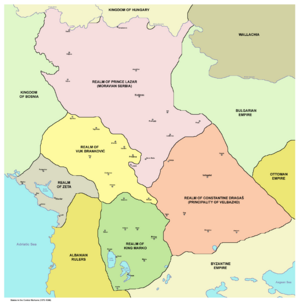Konstantin Dejanović facts for kids
Quick facts for kids
Konstantin Dejanović
|
|
|---|---|
| gospodin (possibly despot) | |

Icon depicting Konstantin Dejanović, Kera-Tamara, Kerica and Desislava (c. 1371)
|
|
| Reign | 1378–1395 |
| Predecessor | Jovan Dragaš |
| Born | before 1355 |
| Died | 17 May 1395 Rovine, Romania |
| Spouse(s) | First wife (unknown) Eudokia of Trebizond
(m. 1387) |
| Issue | first marriage Helena Dragases Three daughters Jakov |
| Father | Dejan |
| Mother | Theodora Nemanjić |
Konstantin (Kostadin) Dejanović (Serbian Cyrillic: Константин (Костадин) Дејановић; fl. 1365–1395), also known as Konstantin Dragaš, was an important Serbian noble. He ruled a large area in eastern Macedonia. His lands were under the control of the Ottoman Empire, meaning he had to obey the Ottoman Sultan. This happened during the time when the Serbian Empire was falling apart.
Konstantin took over from his older brother, Jovan Dragaš. Jovan had become a vassal (a ruler who owes loyalty and service to a more powerful ruler) of the Ottomans after the Battle of Maritsa in 1371. This battle greatly weakened the Serbian nobility. Konstantin and his brother ran their own government. They even made their own coins, similar to the style of the old Nemanjić kings.
In 1392, Konstantin's daughter, Jelena, married Manuel II Palaiologos, who became the Byzantine Emperor. Konstantin himself died in the Battle of Rovine on May 17, 1395. He was fighting for the Ottomans against Wallachia, alongside other Serbian nobles like Stefan Lazarević and Marko Mrnjavčević.
Konstantin's grandson, Constantine XI, became the very last Roman Emperor. He was named after Konstantin and even used the name Dragaš.
Life Story
Early Years
Konstantin's father was a powerful noble named Dejan. Dejan held the Kumanovo region under the rule of Emperor Stefan Dušan (who ruled from 1331 to 1355). Konstantin's mother, Teodora Nemanjić, was Emperor Dušan's half-sister. His grandparents were King Stefan Dečanski and Queen Maria Palaiologina.
His Rule
Around 1365, Konstantin's older brother, Jovan Dragaš, controlled the areas of Štip and Strumica. Jovan was given the title of despot by Emperor Uroš V. This was the same high title their father Dejan had received from Emperor Dušan.
Ottoman records show that in 1373, the Ottoman army forced Jovan Dragaš to become their vassal. Konstantin helped Jovan rule their lands. When Jovan died in 1378 or 1379, Konstantin became the new ruler. He managed to control large parts of northeastern Macedonia and the Struma river valley.
Like his brother, Konstantin also minted his own coins. The Dragaš family gave a lot of money to several monasteries on Mount Athos. These included Hilandar, Pantaleimon, and Vatopédi.
On February 10, 1392, Konstantin's daughter, Jelena, married Manuel II Palaiologos. The very next day, they were crowned Emperor and Empress by the church leader.
After the Battle of Maritsa, Konstantin and his brother had to become vassals of the Ottoman Empire. However, they still kept strong connections with their Christian neighbors, like the Byzantine Empire. In 1395, Konstantin Dragaš and his ally, King Marko of Prilep, were killed. They were fighting for their Ottoman overlord, Sultan Bayezid I, against Mircea cel Bătrân of Wallachia. This battle happened at Rovine, near Craiova. The Ottomans later named Konstantin's capital city, Velbužd, after him. It is now called Köstendil (today's Bulgarian Kyustendil).
Family Life
Konstantin Dejanović was married two times. We do not know the name of his first wife. His second wife was Eudokia of Trebizond. She was the daughter of Emperor Alexios III of Trebizond.
From his first marriage, Konstantin had at least four daughters and possibly a son:
- Helena Dragases (also known as Jelena Dragaš). She later became a nun named Hypomone. She married the Byzantine Emperor Manuel II Palaiologos and passed away on May 13, 1450. Their children included the last two Byzantine emperors. One of them, Constantine XI, added the name Dragaš to his own. Constantine XI was named after his grandfather, Konstantin.
- Three daughters who married into the Ottoman royal family in 1372.
- Jakov. He became a Muslim and was the Lord of Velbužd.
Images for kids



